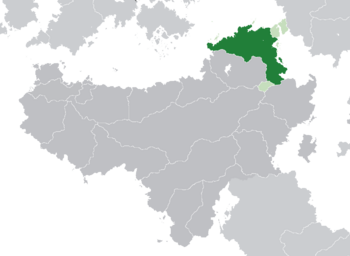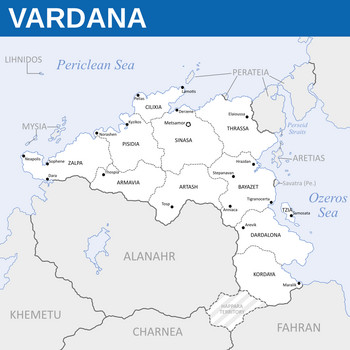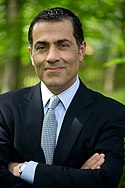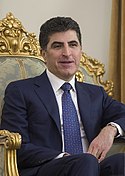Vardana
Republic of Iotopha | |
|---|---|
 Location of Iotopha (dark blue) – in Ochran (dark grey) – in the ORG (light blue) | |
 Political Map of Iotopha | |
| Capital and largest city | Afar |
| Official language | |
| Regional languages | |
| Ethnic groups (2018) |
|
| Religion | Promoted religion: Mazdayasna Recognized minorities: Islam, Christianity (Nestorian, other, other), Judaism, Local religions |
| Demonym(s) | Iotophan |
| Government | Unitary semi-presidential republic under a dominant-party system |
| Fadil Berxwedan | |
• Premier | Siyabend Öcalan |
• Chairman of the Assembly of the People | Sarya Sadeghi |
| Legislature | Assembly of the People |
| Formation | |
• Teispid Empire | c.300 BCE |
• Sadakiyan dynasty | 220 CE |
• Varchonitai conquest | 1092 |
• Petty realms | 1186 |
• Shahdom of Iotopha | 1401 |
• Communist republic | 4 October 1920 |
• Current Constitution | 7 May 1986 |
| Area | |
• | 357,680 km2 (138,100 sq mi) (nth) |
• Water (%) | 7.1% |
| Population | |
• 2018 estimate | 51,202,572 |
• 2015 census | 46,650,421 |
• Density | [convert: invalid number] |
| GDP (PPP) | 2016 estimate |
• Total | $744.485 billion |
• Per capita | $14,540 |
| GDP (nominal) | 2016 estimate |
• Total | $270.964 billion |
• Per capita | $5,292 |
| Gini | 35.4 medium |
| HDI | 0.740 high |
| Currency | Dînar (Ð) (IOD) |
| Date format | dd/mm/yyyy (CE) |
| Driving side | left |
| Calling code | +99 |
| Internet TLD | .io |
Iotopha (Iotophan: Iotophā /ləˈtɒfəɡə/), officially the Republic of Iotopha (Iotophan: Րեպuբլիc ոֆ Իոտոպհա; Iotophā Komara), is a sovereign state in western Ochran. It is boarded to the northeast by Arkoenn, to the east by Benaajab, to the north by BLANK, and to the south by BLANK2, while having a maritime border to the west along the Ozeros Sea. With just over 51 million inhabitants, it is the Xth largest nation in the world, and Xth largest on Ochran.
{Insert a historical blurb here about some ancient history)
After the collapse of X, the {kurdish group} arrived as a recognizable group in southwestern Ochran, establishing the Sadakiyan dynasty, which ruled over much of present day Iotopha until it was replaced by the Shaddadids in the 8th century CE. Successive Mazdayasna-believing dynasties ruled over various portions of southwestern Ochran. A Turkic muslim dynasty eventually displaced the native Mazdayasna ruling class in the 11th century, though it would quickly collapse into numerous petty realms. The rise of the Hadhabani from the coastal islands in the 15th century is credited for the establishment of the Iotophan state and a growing national identity, under a united figure. Under Shah Ardashir II, Iotopha was considered one of the most powerful states in its geopolitical area, though it was engulfed in numerous wars with invading forces from X and Y, which saw it lose territory. By 1920, growing popular unrest was leading to constitutional reforms with the once absolute monarchy, but quickly turned into a violent revolution between royalists and an alliance of left and right-wing radicals, which ultimately culminated in the establishment of the Madzik Democratic Republic of Iotopha. A military coup launched in 1982 saw the communist regime nearly ousted from power, prompting a civil war between the military, communist regime loyalists and a brief royal restoration movement. The conflict ended in 1986 when communist leadership agreed to an armistice with the military leadership to democratize Iotopha.
Today, Iotopha is the Xth largest economy in the world. Though the economy has grown in recent years, it still suffers from high unemployment rate and poverty, and with high income inequality. According to international reports, human rights in Iotopha are considered poor. The regime is considered undemocratic due to the oppressive tactics used against critics of the government and members of the opposition. Iotopha is a member of the Forum of Nations, {other org}, and {other org}.
Etymology
Iotopha is derived from the Hellenic term λωτοφάγοι (lōtophagoi), roughly translating to "lotus-eaters". The term was first applied to the inhabitants of the {NAME} island off the eastern coast of the country, who Hellenic explorers observed regularly consumed lotus fruits. Since the Xth century, Iotopha has been informally used in the area, and was first formally adopted by the Democratic Republic of Iotopha following the 1920 revolution.
History
Prehistory
Classical antiquity
Medieval period
Early modern period
From the 1800s to the 1920s
Contemporary era
Geography
Climate
Iotopha features a diverse climate, ranging from semi-arid in the X to humid in the X to temperate forests in the west near Lake Dhaka.
Fauna
Regions, provinces and cities
Iotopha is divided into six regions, which are further subdivided into 30 provinces, each governed by a governor appointed by the President upon the consent of the Assembly of the People. Provinces are then divided into districts and again into cities, towns, villages or other forms of municipalities.
Iotopha has a high urban growth rate, with urbanization growing from 19% to 68% between 1950 and 2000. The Forum of Nations projects that nearly 75% of the population will be urban by 2030. The largest settlements are Afar, Tisfun, and Sirkap. Overall, there are 7 cities with populations over 1 million, and a total of X with a population over 450,000.
Afar is the capital of Iotopha, and has a population of over 7.8 million. Since 1923, it has been the economical, cultural and focus of the country's transportation and communication networks.
The second largest city in Iotopha is Tisfun, with a population of around 4.1 million, and also serves as the capital of NAME province. It once served as the capital of Shahdom of Iotopha, and seat of the Hadhabani dynasty. Tisfun is a city of key religious importance to Mazdayasnae within Iotopha, as it features the largest and oldest fire temple in the country, Adur Burzen-Mihr.
Politics
Governance

|

|
| Fadil Berxwedan President |
Siyabend Öcalan Premier |
According to the constitution, Iotopha is a unitary semi-presidential republic, wherein the President is the head of state, and the Premier is the head of government. The Democratic Republic of Iotopha is structured as a multi-party democracy with an elected head of state, legislature, and appointed judiciary. The constitution sets out the governing principles and established Iotopha as a centralized state.
The president is directly elected by popular vote every six years, serving as the head of state and chief executive of the country. Legislative power is vested by the unicameral Assembly of the People. The Premier is the head of government and is appointed at the discretion of the president; the Premier can only be removed by the President or a vote of no confidence by the Assembly of the People, though only the President can dissolve the Assembly. The judiciary is nominally independent from both the executive and legislative branches of government, though the president and ruling party are given large powers in appointing or dismissing judges. The High Constitutional Court of Iotopha is the highest court in the country, and is charged with determinations of constitutionality of laws and decrees, while also hearing cases on appeal from lower courts, or stripping political parties of funding or outright banning them.
Law and criminal justice
The Constitution of Iotopha was adopted on 7 January 1986 by popular referendum with 62.4% approval, and took effect on 7 May 1986. The constitution sets out the fundamentals of the government, rule of law, an ideological neutrality of the state, political pluralism, competitive elections and a separation of powers, guaranteeing fundamental human rights to all citizens regardless of religion. Controversially, the constitution did not enshrine Mazdayasna as the state faith, but retained it as a favored and promoted religion.
The President appoints all members of the civil judiciary, and chief public prosecutor upon the consent of the Assembly of the People. There are civil, criminal, and sanctioned religious courts for recognized religions where jurists are appointed among local clerics or priests. Religious courts have no appeal system, but may be brought in civil or criminal courts instead. Special courts are convened for crimes of treason, blasphemy, and attempts to subvert the Constitution.
Foreign Relations
Military
The Democratic Republic of Iotopha has four branches of the military: Army, Navy, Air Force, and People's Guard. There are over 400,000 active soldiers among Iotopha's traditional military branches, and nearly 100,000 in reserve. The People's Guard consists of 90,000 full-time enlisted volunteers. In 2016, Iotopha's military spending represented 2.7% of its GDP or $20.1 billion.
The country has developed its own minor arms industry, but has primarily relied upon foreign suppliers since the collapse of the communist regime in 1986.
Economy
Demographics
Religion
Iotopha is a secular state with no state religion, and freedom of religion is guaranteed under the Constitution of Iotopha. According to the 2015 census, Mazdayasna is the major religion in Iotopha, adhered to by 61% of the population. Irreligion or spiritual but not religious are the next largest groups. A study by the Prince of Youth Institute determined that the communist era's repression of religion was widespread and that anti-religous law instituted before 1972 is the chief cause for these numbers. It is estimated that before 1972, as few as 39% of Iotophans remained Mazdayasna. It was only after 1972, that many anti-religious laws were lifted and Mazdayasna was made a promoted religion. Upon Iotopha's democratization, Mazdayasna was stripped of its promoted status..
The highest Mazdayasna religious figure is the Moabadan-Moabad (High Priest of High Priests), which is responsible for the interpretation of religious law, regulation of priests, and operation of temples and employing local and provincial mobads. People in Iotopha have practiced Mazdayasna since the Teispid Empire in the 4th century BCE. At the time of the revolution in 1920, the religion was throughly ingrained in the monarchy, where it enjoyed official state religion status. Since the revolution, and later democratization, Iotopha is staunchly secular, and until recently most public displays of religion were frowned upon.
A number of other religious groups reside in Iotopha, with Christianity making up 3% of the population. Nestorianism is the largest christian group within the country, followed by Alban Christianity, and Fabrian Catholicism. Judaism and Islam also have a presence in Iotopha, with Shia Islam making up 1% of the population, primarily among the Varchonitai-speaking population. Before the 1920 revolution, followers of the Jewish faith consisted of almost 4% of the population, but the revolution and Yisraeli return laws have seen that number drop to barely 1% of the country's modern population. Around 4% of the population are followers of the Sadhana faith, which is the second largest minority religion in Iotopha.
Languages
Nearly all of the population speaks Iotophan, which is also the only official language of the country. Several other dialects are spoken throughout the country, with Sekharian holding the status of a recognized language for historical purposes. The most recent census shows that nearly 98% of all inhabitants speak Iotophan, though this remains a a topic of debate as many point out that such a statistic is politically motivated.
The largest minority language is Jhilam, which is the native language of an ethnic group of the same name. Jhilam holds the status of a regional language, with most of its speakers living in Heskîf region of eastern Iotopha.
Notable minority languages include Varchonitai, {language}, and {language}. Varchonitai is widely spoken in northwestern Iotopha in Dohuk region along the Arkoenn border.
Ethnic Groups
Ethnic groups within Iotopha are thought to mirror the make up of languages spoken within the country. As with language, Iotophans make up the largest ethnic group in the country; however as with language, there is a political motive suspected to be behind census numbers. The most recent government census reported that 92% of inhabitants were Iotophans. Opponents suggest that this statistic is caused by confusing census questions and documents that lead to a desired outcome. Estimates from NGOs and the BC place ethnic Iotophans are anywhere from 65-77% of the population.
Ethnic Jhilam make up the second largest ethnic group, with NGOs placing around 20% of the population. Due to its location near Scipia, a significant Hellenic population remains along Iotopha's coastal regions. The Hellenic population was once much larger, though saw widespread emigration during and after the 1920 revolution.

